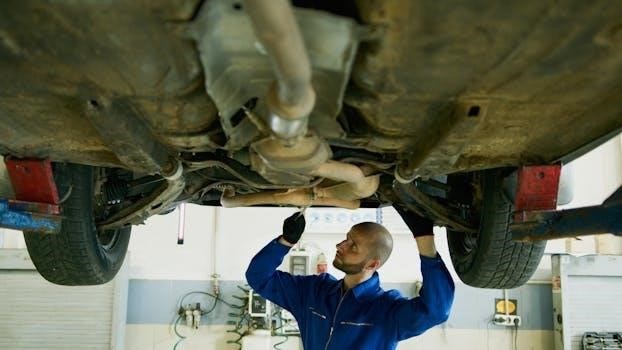JLG Boom Lift Operators Manual⁚ A Comprehensive Guide
This comprehensive guide serves as a supplementary resource alongside your official JLG boom lift operator’s manual. It enhances understanding of safe operation and essential maintenance practices. Always consult the specific manual before operating.
JLG boom lifts represent a leading brand in access equipment, offering solutions for various industries, from construction to maintenance. These aerial work platforms, including cherry pickers and scissor lifts, provide safe and efficient access to elevated work areas. Understanding their operation is crucial.
JLG continually updates its technology and safety features. Familiarizing yourself with the specific JLG boom lift model through its operator’s manual is paramount before operation. These manuals contain essential information regarding safety precautions, operating procedures, and maintenance guidelines, ensuring operators can effectively utilize the equipment while minimizing potential risks.
Proper training and adherence to the manual are key to safe and productive use;
Importance of the Operator’s Manual
The operator’s manual for a JLG boom lift is not merely a document; it’s a critical resource for safe and efficient operation. It contains vital information regarding the equipment’s capabilities, limitations, and potential hazards. Ignoring the manual can lead to accidents, injuries, or even fatalities.
The manual provides detailed instructions on pre-operation inspections, proper startup and shutdown procedures, and emergency protocols. It also outlines maintenance schedules and troubleshooting steps, ensuring the equipment remains in optimal working condition. Regular review and strict adherence to these guidelines are essential for all operators.
The JLG boom lift operator’s manual serves as a crucial tool. It promotes safety, prevents equipment damage, and ensures compliance with industry regulations. Prioritize its use.

Key Sections of the JLG Boom Lift Operator’s Manual
Explore essential sections covering safety, operation, and maintenance. Understand pre-operation checklists, starting procedures, and emergency protocols. Learn about inspection guidelines and necessary repairs for optimal, safe equipment performance.

Safety Precautions and Warnings
Prioritize safety by thoroughly understanding all precautions and warnings outlined in the JLG boom lift operator’s manual. These guidelines are critical for preventing accidents and ensuring operator well-being. Review instructions on proper personal protective equipment (PPE) such as hard hats, safety glasses, and appropriate footwear.
Familiarize yourself with load capacity limits to avoid overloading the platform, which can cause instability. Maintain a safe distance from power lines and other overhead obstructions to prevent electrical hazards. Inspect the work area for potential hazards like uneven terrain or obstacles that could compromise stability.
Understand the importance of regular inspections and maintenance to identify and address any potential mechanical issues. Always follow lockout/tagout procedures during maintenance to prevent accidental startup. Be aware of wind speed limitations, as high winds can significantly affect boom lift stability and safe operation.
Ensure that only trained and authorized personnel operate the equipment. Emphasize the importance of situational awareness and avoiding distractions while operating the boom lift. Adhering to these safety precautions will significantly reduce the risk of accidents and injuries.
Operating Procedures
Mastering the correct operating procedures is paramount for the safe and efficient use of JLG boom lifts. This section outlines the essential steps for operating the equipment, from pre-start checks to shutdown protocols. Always begin with a comprehensive pre-operation inspection, verifying fluid levels, tire pressure, and the functionality of all controls.
Understand the control panel layout and the purpose of each switch and lever. Practice smooth and controlled movements to avoid sudden jerks or abrupt stops that could compromise stability. Familiarize yourself with the boom lift’s range of motion and limitations to prevent collisions with surrounding objects.
Maintain clear communication with ground personnel using hand signals or two-way radios. Be aware of the boom lift’s swing radius and ensure that the area is clear of obstacles and personnel. When working at height, utilize a safety harness and lanyard, attaching it to the designated anchor point on the platform.
Before exiting the platform, ensure the boom lift is parked on a level surface and the brakes are engaged. Following these procedures will promote safe operation and prevent accidents. Always consult the specific model’s operator manual.
Pre-Operation Inspection Checklist
Before each use, a thorough pre-operation inspection is critical. This checklist ensures the JLG boom lift is safe and ready for operation. Begin by checking fluid levels (engine oil, hydraulic fluid, coolant). Inspect for leaks or damage. Examine tires for proper inflation and wear. Verify the battery condition and connections.
Next, test all control functions. This includes boom lift, lower, swing, and drive. Ensure all safety devices are functioning correctly. Check the emergency stop button, alarms, and lights. Inspect the platform for damage and ensure the guardrails are secure.
Examine all structural components for cracks, bends, or corrosion. Check hydraulic hoses and fittings for leaks or damage. Verify that all decals and safety labels are legible. Document the inspection findings in a logbook.
Any defects must be reported and repaired before operating the boom lift. A detailed inspection ensures safe operation. Refer to the specific JLG model’s operator manual.
Starting and Stopping Procedures
The JLG boom lift starting procedure must be followed meticulously. First, ensure the area around the lift is clear of obstructions. Verify that the parking brake is engaged. Insert the key into the ignition and turn it to the “on” position. Wait for the engine to warm up before operating any functions.
Check all gauges and indicators for normal readings. Engage the appropriate controls to lift, extend, or rotate the boom. Operate all functions smoothly and cautiously. Familiarize yourself with the location of the emergency stop button.
To stop the boom lift, retract the boom to its stowed position. Lower the platform to the ground. Engage the parking brake securely. Turn the ignition key to the “off” position. Remove the key to prevent unauthorized use.
Allow the engine to cool down before performing any maintenance. Record any issues or observations in the equipment log. Refer to the JLG operator’s manual for specific model instructions. Following these procedures guarantees safe operation.
Emergency Lowering Procedures
In the event of a malfunction, knowing the JLG boom lift emergency lowering procedures is critical. First, locate the manual lowering valve, typically near the base of the boom. This valve allows for manual control when power is lost. Identify the valve before operating the lift.
Carefully open the manual lowering valve. The boom will slowly descend. Control the descent to avoid sudden drops or collisions. Use caution, as the lowering speed can vary based on the load and model.
If the manual lowering valve is not accessible or functional, consult the operator’s manual for alternate procedures. Some models have auxiliary power units for emergency lowering. These units can provide temporary power to operate the lift functions.
Ensure the area below is clear before initiating any lowering procedure. Communicate with ground personnel to coordinate a safe descent. After lowering, inspect the lift for damage. Report any malfunctions immediately. Remember, safety is paramount.
Maintenance and Inspection Guidelines
Regular maintenance and thorough inspections are crucial for ensuring the safe and efficient operation of JLG boom lifts. Adhering to the maintenance schedule outlined in the operator’s manual is paramount. This includes lubricating moving parts, checking fluid levels, and inspecting hoses and electrical connections.
Daily inspections should include visual checks for damage, leaks, and wear. Verify the functionality of all safety devices, such as alarms and emergency stops. Inspect tires for proper inflation and condition. Ensure all controls operate smoothly and accurately.
Periodic inspections, conducted by qualified technicians, should involve more in-depth assessments. This may include hydraulic system testing, structural inspections, and verification of compliance with safety standards. Keep detailed records of all maintenance and inspections.
Promptly address any identified issues. Replace worn or damaged parts with genuine JLG components. Proper maintenance extends the life of the boom lift. It minimizes downtime and maximizes safety for operators and those nearby.

Troubleshooting and Repair Information
This section provides essential troubleshooting steps for common issues encountered with JLG boom lifts. Refer to the manual for detailed repair procedures and safety precautions before attempting any repairs.
Locating Manual Lowering Valve
The manual lowering valve is a critical component of your JLG boom lift, designed for emergency situations. Knowing its location and operation is paramount for safe equipment handling. Typically, you can find the manual lowering valve situated near the control valve at the boom’s base. Look for clear markings indicating its purpose.
In case of power failure or malfunction, this valve allows you to safely lower the platform. The exact location may vary slightly depending on the specific JLG boom lift model, so consult your operator’s manual for precise instructions and diagrams. Familiarize yourself with this valve before operating the lift.
Regularly inspect the manual lowering valve to ensure it is accessible and free from obstruction. Practice locating it during pre-operation checks to ensure you can quickly find it in an emergency. Remember, safety is paramount when working with aerial lifts.

Accessing JLG Boom Lift Manuals
JLG manuals can be accessed online, allowing you to view, download, and print essential information as needed. Keep safety and operational guides readily available for reference.
Online Resources and Downloads
Accessing JLG boom lift manuals has never been easier, thanks to the extensive online resources available. You can find a wealth of information, including operator manuals, service manuals, and parts catalogs, all readily accessible for viewing, downloading, and printing. JLG’s official website is a primary source, offering up-to-date manuals and technical documentation.
Many third-party websites also host JLG manuals, providing alternative access points. These online resources eliminate the need for physical copies, ensuring that operators and technicians can quickly find the information they need, whether they are in the field or in the workshop. With a few clicks, you can access detailed diagrams, troubleshooting guides, and maintenance schedules.
Take advantage of these digital resources to enhance your understanding of JLG boom lifts and promote safe and efficient operation.
Spare Parts Manuals
Spare parts manuals are crucial for maintaining and repairing JLG boom lifts efficiently. These manuals provide detailed illustrations and part numbers, ensuring you identify and order the correct components for your specific boom lift model. Accessing the correct spare parts manual streamlines the repair process, minimizing downtime and maximizing the lifespan of your equipment.
These manuals typically include exploded views of various boom lift assemblies, making it easier to understand how parts fit together and identify any missing or damaged components. Clear diagrams and precise part numbers reduce the risk of ordering incorrect parts, saving time and money.
Whether you’re performing routine maintenance or tackling a major repair, having the appropriate spare parts manual at your fingertips is essential. Ensure you have the correct manual for your JLG boom lift model to keep your equipment in optimal working condition.
